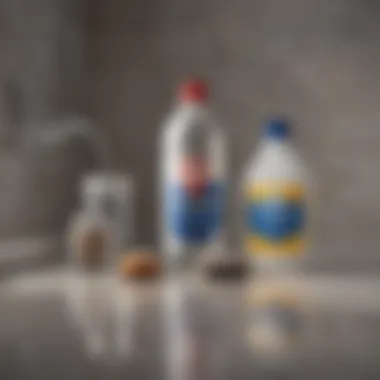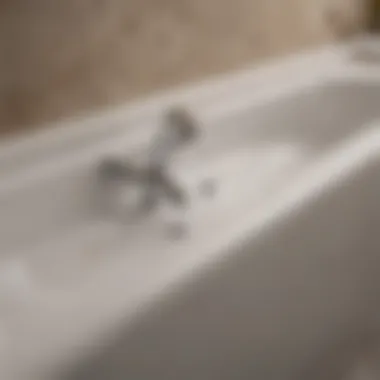Effective Remedies for a Clogged Bathtub Drain


Intro
Clogged bathtub drains can often lead to significant frustration among homeowners. This issue is not merely an inconvenience; it can result in more severe plumbing problems if left unresolved. Understanding the common causes of these clogs helps in developing effective remedies and maintenance strategies. While some may seek immediate fixes, a comprehensive approach that includes identifying root causes and maintaining plumbing systems ensures long-term resolutions.
In this article, we will explore various methods for addressing clogged drains. From simple techniques homeowners can execute themselves to more structured solutions that may require professional intervention, practical insights will be provided. Additionally, preventive measures will be discussed, empowering readers to protect their plumbing systems effectively.
Among the key factors to consider are the specific characteristics of bathtub drains and the common debris that contributes to clogs. Items like hair, soap scum, and mineral buildup often precipitate slow drainage. Identifying these elements can facilitate more efficient remediation methods and reduce the frequency of clogs.
Understanding Clogged Bathtub Drains
A clogged bathtub drain is a common problem many homeowners encounter. Effectively addressing this issue requires understanding what leads to clogs and the signs that indicate a problem. Having knowledge about clogged drains helps one choose the best remedies and preventive measures. Understanding clogged bathtub drains can help save time, money, and frustration.
Common Causes of Clogs
Clogs can be caused by a variety of factors. By identifying these causes, we can take steps to mitigate them and alleviate the issue before it becomes severe.
Hair Accumulation
Hair accumulation is one of the main causes of clogged bathtub drains. Human hair is typically long and can easily aggregate in the drain. Once hair entangles with other debris, it creates a more substantial blockage. This aspect makes hair a persistent issue in drains, as it often is not easily removed during routine cleaning.
The key characteristic of hair accumulation is its ability to bind with substances like soap residue. This tenacity makes it a significant contributor to clogs. Acknowledging its role is very useful for homeowners looking to prevent future blockages. The unique feature of hair buildup is its gradual increase over time, creating more significant problems when left unaddressed.
Soap Scum Buildup
Soap scum buildup forms when soap interacts with minerals found in water. This mixture can create a sticky residue that lines the walls of drains. The accumulation of soap scum over time can narrow the passage in a drain, leading to slow drainage and eventual clogs.
Soap scum is prevalent in many households. The key characteristic here is its sticky nature, which allows it to cling to drainpipes. It is essential to understand that while soap itself is designed to dissolve, the reaction with minerals causes it to harden, which is problematic. This uniqueness means that preventative cleaning is crucial to avoid buildup.
Mineral Deposits
Mineral deposits come from hard water. These deposits can accumulate within drains and pipes, obstructing water flow. Over time, this can lead to stubborn clogs that can be challenging to remove.
The primary aspect of mineral deposits is their composition. Minerals like calcium and magnesium can accumulate. The key characteristic making mineral deposits a concern is their ability to bond with other substances. While they may not seem like an immediate threat, they can become a significant issue if not monitored. This uniqueness means they justify routine maintenance to prevent accelerated buildup.
Signs of a Clogged Drain
Being aware of the signs of a clogged drain can address issues promptly and prevent significant damage.
Slow Drainage
Slow drainage is one of the first indicators of a potential clog. When water takes longer than usual to exit the bathtub, it may suggest that something is obstructing the drain. The key characteristic of slow drainage is how it often signals a developing problem before it becomes a full clog. Regularly checking your drainage can help catch issues early.
The unique feature of slow drainage is that it's often easy to notice during daily activities, making it a beneficial signal for homeowners. Prolonged neglect can lead to more severe blockages, so addressing slow drainage quickly is essential.
Backed Up Water


Backed up water is a more advanced sign of a clog and usually occurs when the drain is fully blocked. In this situation, water will pool in the tub instead of draining. The key characteristic of backed up water is its ability to create a mess, often leading to water damage or sanitation issues. This is a critical sign that requires immediate attention.
The unique feature of this symptom is that it may lead to overflows or leaks if left untreated. Identifying backed up water early on can prevent further complications and maintain the integrity of the plumbing system.
Unpleasant Odors
Unpleasant odors are often indicative of clogs or waste buildup within the pipes. These odors can signal stagnant water or decomposing material in the drain. The key characteristic of unpleasant odors is the warning they provide about underlying issues, making it a helpful sign for homeowners.
Detecting these odors early can prevent more severe problems, including worsening clogs or damage to the plumbing system. This makes it crucial to address any unpleasant smell in the bathroom promptly, as it can indicate deeper plumbing issues.
Initial Assessment of the Problem
Initial assessment is a crucial step when dealing with a clogged bathtub drain. Understanding what you are up against can save time and help avoid costly repairs. Identifying the problem early can lead residents to choose the right method for clearing a blockage. Additionally, engaging in this step prevents deeper issues in the plumbing system which may not be apparent immediately. Assessing the situation accurately allows homeowners to discern between a minor inconvenience and a more severe plumbing issue.
Using a Plunger
A plunger is often the first tool that comes to mind for tackling clogged drains. Many people may not realize how effective it can be for bathtub clogs. Before going for more invasive techniques, using a plunger can dislodge hair or soap buildup that is causing the obstruction.
- Preparation: Start by gathering a standard cup plunger. Ensure the bathtub is partially filled with water, as a few inches can create the necessary suction.
- Placement: Position the plunger over the drain. Make sure it covers the area entirely to achieve the best seal.
- Pumping Action: Press down forcefully and then pull up quickly. Repeat this action multiple times, allowing the pressure to build and hopefully dislodge the clog.
- Testing: After several attempts, check if the water drains more efficiently. If successful, the clog may have been cleared. However, if drainage is still poor, further steps may be required.
Inspecting the Stopper
The bathtub stopper is another critical element to inspect during the initial assessment. Stoppers can become clogged with hair or soap and hinder water flow. It is essential to understand how to examine and potentially clean the stopper itself.
- Removing the Stopper: Depending on the model, you may need to unscrew or simply pull out the stopper. Some pop-up stoppers require a little more finesse during removal.
- Cleaning: Once removed, check for blockages. Clean any hair, soap scum, or debris that has collected around the mechanism. A toothbrush or small brush can be handy for this task.
- Reassembly: After cleaning, carefully reattach the stopper. Make sure it is securely in place.
- Testing Again: With the stopper back in position, run water to see if you notice an improvement in drainage.
By carefully assessing the situation using these two techniques, homeowners can get a clearer picture of the problem. Remember, taking the time to address the issue at this stage often leads to more effective solutions later on.
Home Remedies for Clogged Bathtub Drains
Home remedies for a clogged bathtub drain offer a practical and cost-effective way to tackle persistent drainage issues without resorting to harsh chemicals or professional services. These remedies are necessarily gentle on the plumbing while often being surprisingly effective. Understanding these methods equips homeowners with tools to maintain their plumbing systems better, ensuring a hassle-free bathing experience.
Considering the significance of choosing home remedies, one realizes the immediate benefits they provide. They can prevent the buildup of future clogs and save money in the long term. Moreover, these techniques are often made from ingredients readily found in the household, making them accessible to anyone.
Boiling Water Method
The boiling water method is one of the simplest yet effective techniques for alleviating minor clogs. The heat from the boiling water can dissolve soap scum and other organic materials that often accumulate in drains.
- Prepare the Water: Boil a kettle full of water. The quantity should be sufficient to pour down the drain in multiple batches if necessary.
- Pour Slowly: Once the water reaches boiling point, let it cool for a few seconds before slowly pouring it directly down the drain. Aim for a steady flow and avoid splashing.
- Repeat if Necessary: If the drain is still slow after the first attempt, wait a few minutes and repeat the process.
This method is particularly effective in drains that are heavily affected by soap scum and similar build-ups. However, it is crucial not to use boiling water on plastic pipes, as extreme heat can cause damage in some cases.
Baking Soda and Vinegar Technique
This combination is hailed for its effectiveness in not just clearing clogs but also in deodorizing the drain. This method relies on a chemical reaction between baking soda and vinegar, which produces fizzing action that helps loosen debris.
- Add Baking Soda: Begin by pouring about half a cup of baking soda down the drain.
- Follow with Vinegar: Then, add a half cup of vinegar. It is best to use white vinegar for this purpose.
- Cover and Wait: Cover the drain with a stopper or cloth to contain the fizzing. Allow it to sit for approximately 30 minutes.
- Flush with Hot Water: After the wait, flush the drain with hot water to clear out any remaining material.


This method can be repeated weekly to maintain a clear drain and prevent future blockages. The natural ingredients make this an eco-friendly option.
Salt and Baking Soda Mixture
The combination of salt and baking soda can be another effective remedy to address clogged drains. This duo can maintain cleanliness while boosting the effectiveness of your drain cleaning efforts.
- Mix Ingredients: Combine half a cup of salt with half a cup of baking soda. Ensure they are well mixed.
- Pour Down Drain: Pour the mixture down the drain. It works by breaking down grease and preventing clogs before they start.
- Let it Sit: Leave the mixture in the drain overnight to maximize its effectiveness.
- Flush Out with Hot Water: The next morning, flush with hot water.
This method offers not just a remedy for existing clogs, but also helps in preventing build-up over time. Regular use can ensure the drain remains healthy and free-flowing.
"Using simple household items could save you both time and money when it comes to unclogging your bathtub."
Professional Techniques for Removing Clogs
Addressing clogged bathtub drains requires a multifaceted approach, especially when home remedies fall short. Professional techniques for removing clogs encompass specialized methods that aim to effectively clear blockages, ensuring that drains function seamlessly. These methods are particularly important for homeowners who face recurrent clogs or those whose DIY efforts yield limited results. Professional interventions not only eliminate existing clogs but also provide insights into the underlying causes, reducing the likelihood of future issues.
Snaking the Drain
Snaking a drain is a widely used technique that involves the use of a plumber’s snake, a long, flexible tool designed to reach deep within pipes. This technique is effective for various types of blockages, ranging from hair accumulation to debris build-up. The primary benefit of snaking is its ability to dislodge obstructions without the need for harsh chemicals, making it a more environmentally friendly option.
To perform this technique, a homeowner can either rent a snake or hire a professional plumber skilled in using this tool. The process begins by inserting the snake into the drain, then rotating it as it descends through the pipe. This rotation allows the snake to catch and pull out the debris causing the blockage.
However, there are a few considerations to keep in mind. The effectiveness of snaking largely depends on the nature of the clog and the depth within the plumbing system. Additionally, if a clog persists after snaking, it may indicate a more serious issue necessitating professional diagnosis.
Hydro Jetting
Hydro jetting involves using high-pressure water jets to clear stubborn clogs from pipes. This method is particularly effective for grease buildup and tree root infiltration. Hydro jetting is a more advanced technique that offers several benefits over traditional approaches, including thorough cleaning of pipe walls, and it can often rectify problems that simpler methods cannot.
The process of hydro jetting begins with a thorough inspection of the plumbing system, often performed with a camera, to assess the state of the pipes. This allows for an informed approach, ensuring that the jets target the actual source of the clog. Water is then propelled under high pressure through a specialized nozzle, effectively breaking up and flushing away obstructions.
While hydro jetting is a highly effective method for many homeowners, it should be performed by trained professionals, as misuse can potentially damage older or compromised plumbing systems. The investment in hydro jetting can pay off in the long run by improving the overall condition of plumbing, thus preventing future drainage issues.
"Recognizing the need for professional techniques can save homeowners from prolonged frustration and costly repairs in the future."
In summary, understanding professional techniques for removing clogs is crucial for effective drain maintenance. Whether considering snaking the drain or hydro jetting, each method presents unique advantages tailored to specific clogging issues. Escolhendo the right approach can lead to a more reliable and efficient plumbing system.
Chemical Solutions for Stubborn Clogs
Dealing with stubborn clogs can sometimes necessitate the use of chemical solutions when traditional methods fail. While these chemicals can be effective, they require careful handling due to their potential risks. Understanding the appropriate chemical solutions available offers homeowners practical options to tackle tough blockages and restore the functionality of bathtub drains.
Enzyme-based Cleaners
Enzyme-based cleaners serve as a safer alternative to harsh chemical products. These cleaners contain natural enzymes that break down organic materials commonly found in drains, such as hair, soap, and grease. The primary benefit of using enzyme-based cleaners is their non-toxic nature. They do not produce harmful fumes, making them a suitable choice for households with children or pets. Additionally, they are biodegradable, which makes them environmentally friendly.
To effectively use enzyme-based cleaners, make sure to follow the manufacturer's instructions. Typically, this involves pouring the recommended amount into the drain and letting it sit undisturbed for several hours or overnight. This waiting period allows the enzymes to work through the clog effectively.
"Enzyme-based cleaners are gentle yet effective, offering a solution without the harsh effects of traditional chemicals."


Caustic Soda Method
The caustic soda method uses sodium hydroxide to dissolve stubborn clogs. This method is powerful but should be approached with caution. Sodium hydroxide is highly corrosive and can cause burns; therefore, protective gear is necessary, including gloves and goggles. Additionally, ensure the area is well-ventilated.
To use this method, follow these steps:
- Preparation: Wear protective gloves and goggles to prevent any injury from splashes.
- Mixing: Carefully mix one cup of caustic soda with one gallon of water in a bucket. Stir until the caustic soda is fully dissolved.
- Application: Slowly pour the solution into the affected drain. The reaction will generate heat and may create bubbles as it works to dissolve the clog.
- Rinsing: After allowing the solution to sit for about twenty minutes, flush the drain with hot water to remove any residual material.
Although effective, the caustic soda method may not be suitable for all plumbing systems, particularly those with older pipes or fixtures. Thus, consider consulting a plumbing professional if there are concerns about its compatibility.
Preventive Maintenance for Bathtub Drains
Preventive maintenance is essential for anyone looking to avoid the hassle of clogged bathtub drains. It involves a series of proactive measures to ensure drains remain free-flowing. Addressing the potential causes of clogs before they develop into significant issues can save time, effort, and money. Homeowners who engage in regular maintenance can enjoy uninterrupted use of their bathtubs as well as extend the lifespan of their plumbing systems.
Regular Cleaning Practices
Routine Hair Removal
Hair buildup is one of the primary contributors to clogged bathtub drains. Implementing a routine hair removal practice is critical to prevent these blockages. Regularly checking the drain allows homeowners to remove visible hair, which often catches on the stoppers or in the drain itself. The key characteristic of this practice is its simplicity and effectiveness. It is a beneficial choice for maintaining clear drains because it targets a common cause of clogs right at the source.
The unique feature of routine hair removal is that it does not require special tools or chemicals. Homeowners can easily pull out hair using their fingers or a pair of tweezers without any cost. Its advantage lies in the low effort needed and the significant prevention it can offer against more severe clogs down the line. However, it does require diligence and must be done routinely to ensure optimal results.
Using Drain Screens
Using drain screens is another effective preventive measure. These screens act as a barrier to prevent hair, soap scum, and other debris from entering the drain. The key characteristic here is their ease of installation and usage, along with the reduced frequency of drain clogs. Adding a drain screen can be a straightforward choice for homeowners aiming to reduce maintenance efforts over time.
The unique feature of drain screens is that they capture debris while still allowing water to flow unimpeded. Their advantages include ease of cleaning—the screens can be removed and rinsed off regularly to maintain their efficiency. On the downside, some styles may not fit well into all bathtub designs, and they require occasional replacement if they become damaged.
Understanding Your Plumbing System
Understanding one’s plumbing system is vital for effective preventive maintenance. Homeowners should familiarize themselves with the layout, including pipes and traps. Recognizing how water flows through the system helps in identifying potential trouble spots more readily. Being aware of the plumbing might also help in understanding the effects of certain products on the drains.
In doing so, homeowners can make informed decisions when implementing cleaning techniques or selecting products. They can avoid situations where a cleaning agent might not be suitable for their particular plumbing materials. Additionally, knowing the system can aid in timely troubleshooting if issues do arise, thus contributing to better overall maintenance of bathtub drains.
End
Addressing the issue of a clogged bathtub drain requires a thoughtful and systematic approach that encompasses both immediate solutions and long-term preventative measures. This conclusion highlights the significance of understanding the various methods discussed throughout the article, emphasizing not only their effectiveness but also their practicality for homeowners.
Recap of Key Methods
In the journey of unclogging bathtub drains, several key methods stand out:
- Home Remedies: Simple techniques using household items like baking soda, vinegar, or boiling water can often resolve minor clogs without the need for harsh chemicals.
- Professional Techniques: For more stubborn blockages, methods such as snaking the drain or hydro jetting offer powerful solutions that can restore flow effectively.
- Chemical Solutions: While not the first line of defense, enzyme-based cleaners or caustic soda can be helpful for particularly resistant clogs, provided they are used with care and according to instructions.
- Preventive Maintenance: Regular cleaning practices and a basic understanding of your plumbing system can go a long way in preventing future clogs.
"Prevention is often more effective than the cure when it comes to plumbing issues."
Final Recommendations for Homeowners
Homeowners should approach drained maintenance with a proactive mindset. Here are some final recommendations:
- Regular Cleaning: Implement a routine cleaning schedule for your bathtub drain to remove hair and soap scum before they become significant problems.
- Use Drain Screens: Consider installing drain screens to catch hair and debris before they enter the plumbing system. This simple measure can significantly reduce the incidence of clogs.
- Educate Yourself: Take the time to understand your plumbing system and potential causes of clogs. This knowledge will enable you to address minor issues before they escalate.
- Know When to Call an Expert: If simple methods do not yield positive results, don’t hesitate to refer to professionals. Their expertise can save time and prevent further damage to your plumbing system.
By following these insights and solutions, homeowners can keep their bathtub drains flowing freely and avoid the frustration that comes with clogged plumbing.















